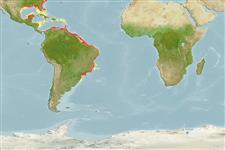Environment: milieu / climate zone / depth range / distribution range
Ecology
Marine; demersal; depth range 70 - 110 m (Ref. 126840). Tropical; 34°N - 33°S
Western Atlantic: South Carolina, USA and northern Gulf of Mexico to Brazil.
Size / Weight / Age
Maturity: Lm ? range ? - ? cm
Max length : 16.0 cm TL male/unsexed; (Ref. 7251)
Dorsal spines (total): 12; Dorsal soft rays (total): 9; Anal spines: 3; Anal soft rays: 5. Occipital pit present; two spines on part of preorbital overlapping maxillary; supplemental preopercular spine present; no dark spot on inner basal part of pectoral fin; dark brown spots on membrane between third and fourth and fifth and seventh dorsal spines; no spines on suborbital ridge; eye diameter 0.9-1.5 times of snout length (Ref. 13608).
Occurs from near shore to 110 m depth (Ref. 7251).
Life cycle and mating behavior
Maturity | Reproduction | Spawning | Eggs | Fecundity | Larvae
Robins, C.R. and G.C. Ray, 1986. A field guide to Atlantic coast fishes of North America. Houghton Mifflin Company, Boston, U.S.A. 354 p. (Ref. 7251)
IUCN Red List Status (Ref. 130435: Version 2024-1)
Threat to humans
Harmless
Human uses
Tools
Special reports
Download XML
Internet sources
Estimates based on models
Preferred temperature (Ref.
123201): 22.7 - 27.9, mean 26.1 °C (based on 610 cells).
Phylogenetic diversity index (Ref.
82804): PD
50 = 0.5000 [Uniqueness, from 0.5 = low to 2.0 = high].
Bayesian length-weight: a=0.01318 (0.00635 - 0.02739), b=3.02 (2.85 - 3.19), in cm total length, based on LWR estimates for this Genus-body shape (Ref.
93245).
Trophic level (Ref.
69278): 3.6 ±0.2 se; based on size and trophs of closest relatives
Resilience (Ref.
120179): Medium, minimum population doubling time 1.4 - 4.4 years (Preliminary K or Fecundity.).
Fishing Vulnerability (Ref.
59153): Low vulnerability (10 of 100).
Nutrients (Ref.
124155): Calcium = 223 [116, 516] mg/100g; Iron = 1.29 [0.68, 2.64] mg/100g; Protein = 17.8 [16.2, 19.3] %; Omega3 = 0.416 [0.172, 1.163] g/100g; Selenium = 47.6 [22.1, 126.3] μg/100g; VitaminA = 42.1 [14.4, 120.3] μg/100g; Zinc = 1.44 [0.99, 2.16] mg/100g (wet weight);
